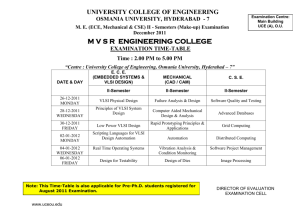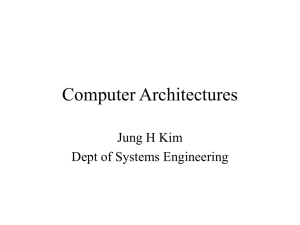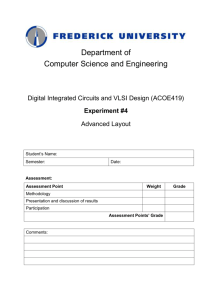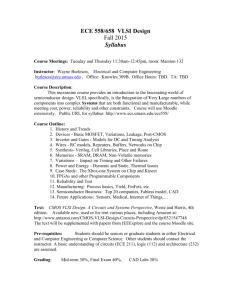Lecture2 Design Metrics
advertisement
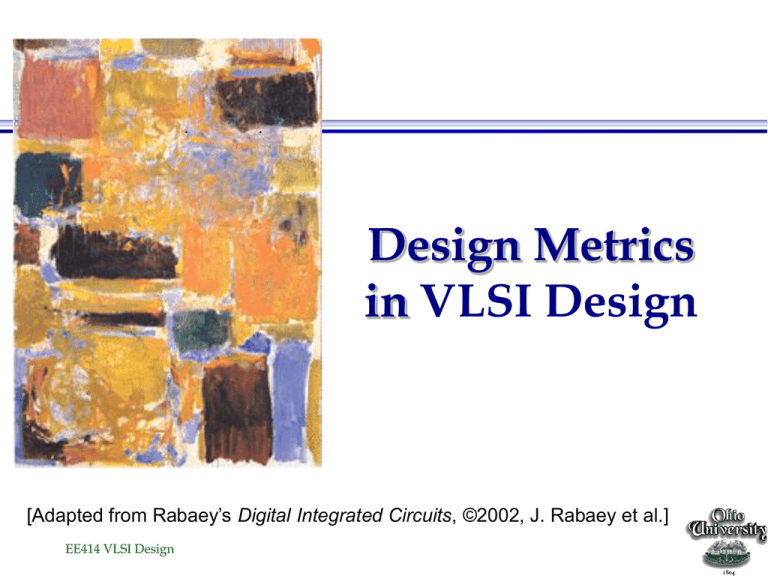
Design Metrics in VLSI Design [Adapted from Rabaey’s Digital Integrated Circuits, ©2002, J. Rabaey et al.] EE414 VLSI Design Design Metrics How to evaluate performance of a digital circuit (gate, block, …)? » Cost » Reliability » Scalability » Speed (delay, operating frequency) » Power dissipation » Energy to perform a function EE414 VLSI Design Design Metrics 34 nm 32 GbFlash memory chip (Intel) EE414 VLSI Design Cost of Integrated Circuits NRE (non-recurrent engineering) costs » design time and effort, mask generation » one-time cost factor Recurrent costs » silicon processing, packaging, test » proportional to volume » proportional to chip area EE414 VLSI Design NRE Cost is Increasing EE414 VLSI Design Die Cost Single die Wafer Going up to 12” (30cm) From http://www.amd.com EE414 VLSI Design Cost per Transistor cost: ¢-per-transistor 1 0.1 Fabrication capital cost per transistor (Moore’s law) 0.01 0.001 0.0001 0.00001 0.000001 0.0000001 1982 1985 EE414 VLSI Design 1988 1991 1994 1997 2000 2003 2006 2009 2012 Yield No. of good chips per wafer Y 100% Total number of chips per wafer Wafer cost Die cost Dies per wafer Die yield wafer diameter/2 2 wafer diameter Dies per wafer die area 2 die area EE414 VLSI Design Defects Yield =25% Yield = 83% defects per unit area die area die yield 1 is approximately 3 die cost f (die area) 4 EE414 VLSI Design Yield Examples (1994) Chip Metal Line layers width Wafer cost Def./ Area Dies/ Yield cm2 mm2 wafer Die cost 386DX 2 0.90 $900 1.0 43 360 71% $4 486 DX2 3 0.80 $1200 1.0 81 181 54% $12 Power PC 601 4 0.80 $1700 1.3 121 115 28% $53 HP PA 7100 3 0.80 $1300 1.0 196 66 27% $73 DEC Alpha 3 0.70 $1500 1.2 234 53 19% $149 Super Sparc 3 0.70 $1700 1.6 256 48 13% $272 Pentium 3 0.80 $1500 1.5 296 40 9% $417 EE414 VLSI Design Example You want to start a company to build a wireless communications chip. How much venture capital must you raise? Because you are smarter than everyone else, you can get away with a small team in just two years: » Seven digital designers » Three analog designers » Five support personnel From lecture : Scaling and Economics by David Harris EE414 VLSI Design Solution Digital designers: » » » » » $70k salary $30k overhead $10k computer $10k CAD tools Total: $120k * 7 = $840k » » » » $100k salary $30k overhead $10k computer $100k CAD tools Total: $240k * 3 = $720k $45k salary $20k overhead $5k computer Total: $70k * 5 = $350k Fabrication » Back-end tools: $1M » Masks: $1M » Total: $2M / year Analog designers » » » » » Support staff Summary » 2 years @ $3.91M / year » $8M design & prototype From lecture : Scaling and Economics by David Harris EE414 VLSI Design Reliability― Noise in Digital Integrated Circuits v(t) VDD i(t) (a) Inductive coupling EE414 VLSI Design (b) Capacitive coupling (c) Power and ground noise DC Operation Voltage Transfer Characteristic V(y) V VOH = f(VOL) VOL = f(VOH) VM = f(VM) f OH V(y)=V(x) VM Switching Threshold VOL VOL V OH V(x) Nominal Voltage Levels EE414 VLSI Design Mapping between analog and digital signals "1" V OH V IH V(y) V Slope = -1 OH Undefined Region V IL "0" V OL EE414 VLSI Design Slope = -1 VOL V IL V IH V(x) Definition of Noise Margins "1" V OH Noise margin high NMH V IH Undefined Region V OL NML V IL "0" Gate Output EE414 VLSI Design Gate Input Noise margin low Noise Budget Allocates gross noise margin to expected sources of noise Differentiate between fixed and proportional noise sources Sources: supply noise, cross talk, interference, offset Shielding: metal lines and guard rings used to lower signal interference EE414 VLSI Design Key Reliability Properties Absolute noise margin values are deceptive » a floating node is more easily disturbed than a node driven by a low impedance (in terms of voltage) Noise immunity is the more important metric – the capability to suppress noise sources Key metrics: Noise transfer functions, Output impedance of the driver and input impedance of the receiver; EE414 VLSI Design Regenerative Property out v3 out finv (v) f(v) v1 v1 v3 finv(v) v2 v0 Regenerative EE414 VLSI Design in f(v) v0 v2 Non-Regenerative in Regenerative Property … v0 v1 v2 v3 v4 v5 (a) A chain of inverters V (Volt) 5 v0 3 v1 1 –1 (b) Simulated response of chain of MOS inverters 0 2 4 6 t (nsec) EE414 VLSI Design v2 8 10 v6 Fan-in and Fan-out •Fan-out: •Number of load gates, N, that are connected to the output of the driving gate •tends to lower the logic levels •deteriorates dynamic performance •gate must have low output resistance to drive load •library cells have maximum fan-out specification •Fan-in: •Number of inputs, M, to the gate •large fan-in gates are more complex •results in inferior static and dynamic performance EE414 VLSI Design Fan-in and Fan-out (a) Fan-out N M N EE414 VLSI Design (b) Fan-in M The Ideal Gate Vout Characteristics Ri = Ro = 0 g= Fanout = Vin EE414 VLSI Design NMH = NML = VDD/2 An Old-time Inverter 5.0 V ou t (V) 4.0 NML 3.0 2.0 VM NMH 1.0 0.0 EE414 VLSI Design 1.0 2.0 3.0 Vi n (V) 4.0 5.0 Delay Definitions Vin 50% t Vout tpHL tpLH 90% 50% 10% tf EE414 VLSI Design t tr Ring Oscillator v v 0 v VDD v 1 2 v 1 0 v v 3 v tp VDD/2 T = 2 tp N EE414 VLSI Design v 4 3 5 v 5 A First-Order RC Network R vin vout C tp = ln (2) t = 0.69 RC Important model – matches delay of inverter EE414 VLSI Design Power Dissipation Instantaneous power: p(t) = v(t)i(t) = Vsupplyi(t) Peak power: Ppeak = Vsupplyipeak Average power: Vsupply t T 1 t T Pave p(t )dt isupply t dt t T t T EE414 VLSI Design Energy and Energy-Delay Power-Delay Product (PDP) = E = Energy per operation = Pav tp Energy-Delay Product (EDP) = quality metric of gate = E tp EE414 VLSI Design A First-Order RC Network Vdd E0->1 = C LVdd2 R isupply PMOS NETWORKvout A1 AN vin NMOS CL Vout CL NETWORK T E = P t dt = V i t dt = V 01 dd sup ply dd 0 0 T E Vdd T T = P t dt = V i t dt = ca p cap out ca p 0 0 EE414 VLSI Design Vdd 0 C dV = C V 2 L out L dd 1 2 C V dV = -C V L out out dd 2 L 0 Summary Digital integrated circuits have come a long way and still have some potential left for the coming decades Some interesting challenges ahead » Getting a clear perspective on the challenges and potential solutions » Understanding the design metrics that govern digital design is crucial » Optimize the design metrics - cost, reliability, speed, power and energy dissipation EE414 VLSI Design
